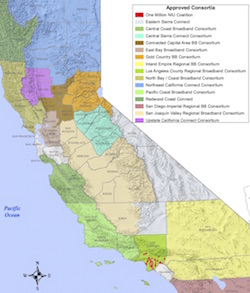
Click for the big picture.
Regional broadband consortia will be getting another $5 million from the California Advanced Services Fund (CASF), assuming governor Jerry Brown agrees. The state senate unanimously approved a bill yesterday that adds the money to the $10 million already allocated and largely spent by the 17 consortia that cover all but a handful of California’s 58 counties (h/t to Gladys Palpallatoc at CETF for the heads up).
The California Public Utilities Commission starting approving consortia in 2011, after the program was established by the legislature in 2010. Different regions have different needs, with some, particularly in rural areas, focusing on developing broadband infrastructure and other, mostly in urban areas, pushing for greater broadband adoption.
Some consortia, such as the Central Coast and Redwood Coast groups, can trace their lineage back a decade or more. Many more were developed by the California Emerging Technology Fund as part of its mission to expand broadband availability and usage throughout the state. Others came in being once the money was available.
Most of the projects proposed over the past several years for infrastructure construction grants from CASF were helped along the way by consortia. A lot of ground breaking analytical and mapping work was also done.
The $5 million is coming out of the CASF broadband infrastructure loan fund. Originally set at $15 million, it’s been tapped once already – also to the tune of $5 million – to fund broadband programs and facilities for public housing. With the governor’s signature, it’ll be down to $5 million.
But only three CASF loans, totalling $127,000, have been approved, versus dozens of infrastructure grants. Not surprising: money you don’t have to pay back is more attractive than money you do. Even so, it could become more popular in the near future since the CASF grant account could be running dry in a few months, while the loan program is intended to live on as a revolving fund.
